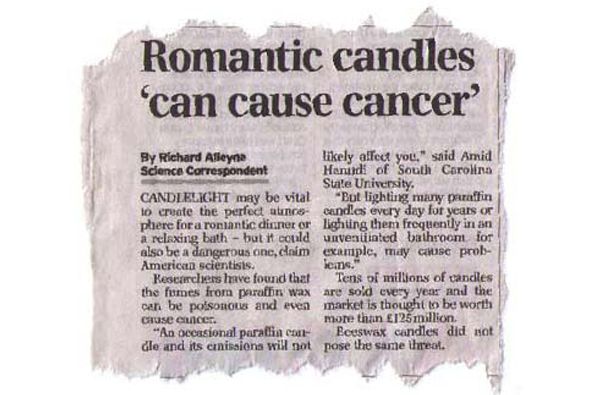This article is part 1 of the Top 20 Rebuttals to Win an E-Cigarette Debate

Photo credit: Viveca Koh
High ranking government officials have busy lives, fielding one bill after another and must receive countless suggestions from citizens on a daily basis. They are not expected to be all-knowing in every field of law, engineering, or health and medicine that provides the backbone for our legal rights. What we should expect from them is a corruption-free fight for what's best for the public interest. This includes conducting thorough research before drafting any bills that may or may not be designed to protect their citizens. Therefore, governments have no business claiming electronic cigarettes to be a public health hazard without any substantial evidence.
Banning smoking in public buildings and gathering places is completely justifiable, as cigarettes have been proven to be dangerous for both smokers and non-smokers alike. However, when it comes to electronic cigarettes, a relatively new smoking alternative, many people just don't know what the health repercussions, if any, are to the user and general public.
We understand not everyone is as dedicated as we are to finding out everything there is to know about electronic cigarettes. Maybe an impartial assistant could be assigned to all the research for matters like this.
Many news pieces on the topic are given sensationalized titles to create controversy and attract more views and comments, thereby, increasing ad revenue. These can be easily misinterpreted by a casual reader just glossing over the article. In a worst-case scenario, maybe money and corruption are in play, causing some studies to be grossly misguided. Fortunately for vapers, there is substantial evidence showing electronic cigarettes to be far safer than the traditional tobacco variety.
Key Points
- ClearStream-Air found no nicotine, carbon monoxide in the air of enclosed room as a result of e-cigarette vapor.
- The scientific journal Inhalation Toxicology concluded electronic cigarette vapor does not pose a threat to bystanders.
- Exponent's reviews of four NJOY brand e-cigs found only one TSNA in the vapor and at levels far below the limit of quantification, comparable to those of FDA approved nicotine inhalers.
- Tobacco Control tested 12 brands of e-cigs and found toxicant levels of up to 450 times lower than those of tobacco cigarettes.
- E-cigarettes are safer than paraffin candles and air fresheners.
Regarding Secondhand Vapor and Passive Vaping
Two separate studies published in 2012 and 2013 compared e-cig vapor to tobacco smoke in an enclosed room. Both concluded that there was no significant risk to human health associated from passive vaping while tobacco smoke produced levels of toxins above the legal threshold.

ClearStream-Air Study
Contrary to what your local senator may believe, there is, in fact, a great deal of evidence supporting the safety of electronic cigarettes for not only the user but also bystanders. One of the most widely cited studies on passive electronic cigarette vapor was published last September by scientists from ClearStream-Air. The study involved two sessions comparing air quality in a room after participants had been smoking to that of the room after the five volunteers had been vaping.
The five smokers consumed 19 cigarettes over 5 hours while the vapers consumed 1.6ml e-liquid, dispensing 17.6 mg of nicotine. No, I repeat, no nicotine was found in the air during the vaping session while 34µg/m3 of nicotine was detected during the period in which volunteers smoked cigarettes. Furthermore, no carbon monoxide, propylene glycol, acrolein, or PHAs was detected in the air while participants were puffing on e-cigs. The scientists concluded that, because of the absence of combustion and sidestream smoke, it would be more unhealthy to breathe the air of a large city than to stay in a room with someone who is vaping.
Indoor Vapor Air Quality Study (IVAQS)
One month after the Clearstream-Air study was published, the journal Inhalation Toxicology published a similar experiment comparing indoor air quality from e-cig vapor with smoke from tobacco cigarettes. A team from CHANGE and CARES vaporized four different “high nicotine” liquids in generic two piece electronic cigarettes and found very similar results to those of the Clearstream-Air study.
After comparing the air quality of both nicotine delivery systems in a 40 m3 room, the team found that tobacco cigarette smoke exceeded most limits for significant risk to human health. Electronic cigarettes, on the other hand, produced very small exposures to pollutants and emissions didn't warrant any apparent risk to bystanders.
Regarding Reports of Nitrosamines in E-Cigs
A 2009 FDA report found trace amounts of tobacco specific nitrosamines in the cartridges of two brands of electronic cigarettes. The FDA did not test the vapor for TSNAs, or at least did not disclose any results on their findings. TSNAs are carcinogenic chemical compounds typically found in cigarettes and other tobacco products. They are harmful for human consumption above certain levels. In the United States, a maximum of 60 parts per billion are allowed.
Exponent/NJOY TSNA Analysis
Granted this was funded by NJOY, one of the more renown manufacturers of electronic cigarettes, but it's worth noting that former Surgeon Dr. General Richard Carmona recently appointed to the company's board of directors. Shortly after the FDA published their results in a press release, NJOY contracted Exponent Inc., an engineering and scientific consulting firm, to analyze and review the levels of four TSNA compounds in the vapor of their e-cigs. They believed levels of nitrosamines and other toxins found in the FDA study to be below limits of quantification and at or below those found in approved Nicotrol Inhalers.
Exponent found that the FDA essentially misinterpreted their own findings. Furthermore, the Nicotrol Inhaler, used as a control for the study, was not tested for the same carcinogens and toxins found in NJOY's electronic cigarettes. In reality, levels of TSNAs and tobacco-specific impurities found in the cartridges were indeed similar to or lower than those found in FDA approved smoking cessation products like nicotine patches, gum, lozenges, and inhalers. Only one out of the four TSNAs, NAT, was actually detected in the vapor. Neither NAT nor any of the impurities were found at levels above the limits of quantification and far lower than levels found in tobacco cigarettes.
Tobacco Control Study
The majority of studies haven't found any nitrosamines in the vapor of electronic cigarettes. In March, the journal Tobacco Control published the findings of an independent 2012 study involving 12 brands of e-cigs. The team of Polish and American scientists went into more detail than the FDA study.
Tobacco Control concluded that electronic cigarettes may substantially reduce exposure to tobacco-specific toxicants. Levels found were between 9 and 450 times lower than those found in tobacco cigarette smoke and were comparable with the trace amounts found in nicotine inhalers.
In Comparison to Air Fresheners
Clean indoor air acts cover the act of smoking because of the objective impact on air quality and objective risk to bystanders. They don't cover paraffin candles or glade plugins even though those present a moderate risk to bystanders. The key difference between a plug in air freshener and an e-cigarette is e-cigarettes use non-toxic ingredients.

E-cigarettes use a propylene glycol and/or vegetable glycerin base where both paraffin candles and plug-ins use an isoparaffinic base which is basically kerosene. If you're asking about the nicotine, that's allowed indoors at 40% concentration. Traditional cigarettes with side stream smoke never posed a risk to bystanders in terms of it, save close exposure equal to the nicotine in a serving of eggplant.
The EPA has found formaldehyde, petrochemicals, p-dichlorobenzene and aerosol pollutants in most store bought air fresheners. Furthermore, a 2006 UC Berkeley study concluded that many household cleaners and air fresheners emit toxic pollutants at levels that may exceed regulatory guidelines and lead to health risks. However the consensus coming from the EPA is that, when properly used, air fresheners are safe.
As such, wherever candle burning is allowed, which poses a greater risk, logically e-cigarettes should be allowed. As property owners choose whether to use candles or not, logically property owners should choose whether to allow e-cigarettes, or encourage people to continue to smoke outside.
Summary
It's understandable that a busy politician and average Joe may not be equipped with the information provided by the aforementioned e-cig studies. Heck, just re-reading over each of them in order to write this rebuttal was pretty time consuming. The public health issue is arguably the most controversial topic on the dockets of bills regulating electronic usage.
This rebuttal presented four separate studies that each found no risk to the public health. While electronic cigarettes can contain nicotine, their vapor has shown to be free of the drug and contain safe, or no levels of toxins. The data presented proves e-cigarettes to be exponentially safer than combusted tobacco and therefore should not be subjected to the same laws. And as always, please use some common courtesy and etiquette when vaping in public places. Creating a positive image will only help the progression of electronic cigarettes in the long run.
See also: Drexel University School of Public Health Study Finds E-Cigarette Vapor Does Not Pose Risk to Health


